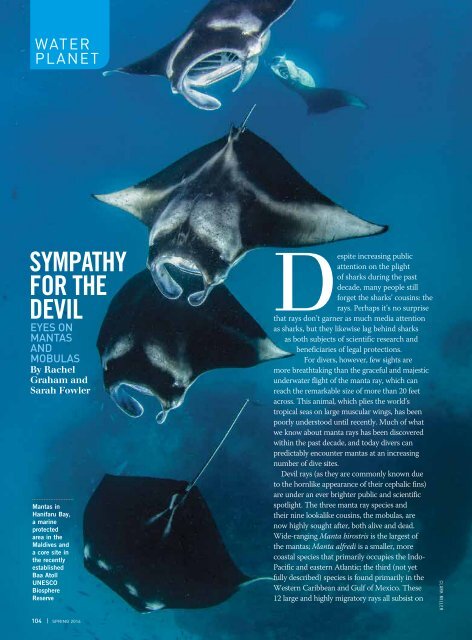AD 2016 Q2
As we pointed out in the spring 2013 edition of the Alert Diver, even being a dive buddy has potential legal implications. So, to bump this up a notch, what about the diver training organisations themselves? Where do they stand? How do they relate to South African law? Are they all considered the same under our legal system in spite of the differences in organisational structures and training programmes? How does this affect their respective instructors and trainee divers from a legal perspective? These are not exactly simple questions. It is certainly true that the respective training organisations differ in a number of ways. However, this does not imply that there are necessarily differential legal implications for each of them. In fact, under South African law, the legal principles are common in all matters. Therefore, if you suffer a loss and you (or your estate in the case of a fatality) wish to recover damages, the legal principles would be applied commonly; whether you are driving or diving. Although not a frequent occurrence, there have been quite a number of law suits associated with diving injuries and damages in South Africa. This is not surprising, as the occurrence of law suits is really a function of “numbers”. As training increases, so do the chances of injuries and, with it, the chances of legal recourse. So, it remains wise to insure yourself, your equipment or your business in a proper and effective way. But before getting back to the potential differences amongst the training agencies, let’s first explore the foundational legal principles on which any civil claim would be adjudicated: inherent risk, negligence and duty to take care.
As we pointed out in the spring 2013 edition of the Alert Diver, even being a dive buddy has potential legal implications. So, to bump this up a notch, what about the diver training organisations themselves? Where do they stand? How do they relate to South African law? Are they all considered the same under our legal system in spite of the differences in organisational structures and training programmes? How does this affect their respective instructors and trainee divers from a legal perspective? These are not exactly simple questions.
It is certainly true that the respective training organisations differ in a number of ways. However, this does not imply that there are necessarily differential legal implications for each of them. In fact, under South African law, the legal principles are common in all matters. Therefore, if you suffer a loss and you (or your estate in the case of a fatality) wish to recover damages, the legal principles would be applied commonly; whether you are driving or diving.
Although not a frequent occurrence, there have been quite a number of law suits associated with diving injuries and damages in South Africa. This is not surprising, as the occurrence of law suits is really a function of “numbers”. As training increases, so do the chances of injuries and, with it, the chances of legal recourse.
So, it remains wise to insure yourself, your equipment or your business in a proper and effective way. But before getting back to the potential differences amongst the training agencies, let’s first explore the foundational legal principles on which any civil claim would be adjudicated: inherent risk, negligence and duty to take care.
You also want an ePaper? Increase the reach of your titles
YUMPU automatically turns print PDFs into web optimized ePapers that Google loves.
WATER<br />
PLANET<br />
SYMPATHY<br />
FOR THE<br />
DEVIL<br />
EYES ON<br />
MANTAS<br />
AND<br />
MOBULAS<br />
By Rachel<br />
Graham and<br />
Sarah Fowler<br />
Mantas in<br />
Hanifaru Bay,<br />
a marine<br />
protected<br />
area in the<br />
Maldives and<br />
a core site in<br />
the recently<br />
established<br />
Baa Atoll<br />
UNESCO<br />
Biosphere<br />
Reserve<br />
Despite increasing public<br />
attention on the plight<br />
of sharks during the past<br />
decade, many people still<br />
forget the sharks’ cousins: the<br />
rays. Perhaps it’s no surprise<br />
that rays don’t garner as much media attention<br />
as sharks, but they likewise lag behind sharks<br />
as both subjects of scientific research and<br />
beneficiaries of legal protections.<br />
For divers, however, few sights are<br />
more breathtaking than the graceful and majestic<br />
underwater flight of the manta ray, which can<br />
reach the remarkable size of more than 20 feet<br />
across. This animal, which plies the world’s<br />
tropical seas on large muscular wings, has been<br />
poorly understood until recently. Much of what<br />
we know about manta rays has been discovered<br />
within the past decade, and today divers can<br />
predictably encounter mantas at an increasing<br />
number of dive sites.<br />
Devil rays (as they are commonly known due<br />
to the hornlike appearance of their cephalic fins)<br />
are under an ever brighter public and scientific<br />
spotlight. The three manta ray species and<br />
their nine lookalike cousins, the mobulas, are<br />
now highly sought after, both alive and dead.<br />
Wide-ranging Manta birostris is the largest of<br />
the mantas; Manta alfredi is a smaller, more<br />
coastal species that primarily occupies the Indo-<br />
Pacific and eastern Atlantic; the third (not yet<br />
fully described) species is found primarily in the<br />
Western Caribbean and Gulf of Mexico. These<br />
12 large and highly migratory rays all subsist on<br />
CLARK MILLER<br />
104 | SPRING <strong>2016</strong>









